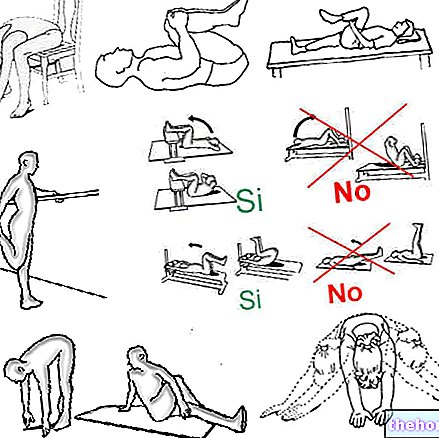"Causes and symptoms
Care and treatment
The treatment of plantar fasciitis is based on initial rest and control of inflammation. So let's see what are the most important rules to follow to facilitate healing.
Rest
Suspend workouts for a few weeks and avoid walking or standing for too long, especially on hard surfaces. Initial rest usually helps relieve pain and reduce local inflammation.
It is very important to stop training at the first signs of plantar fasciitis: ignoring the pain by continuing to train or suppressing it with specific drugs, in fact, favors the chronicization of the disease, considerably complicating its treatment.
If the pain is particularly intense and accentuated by the load, the subject should not hesitate to use crutches to completely unload the sore foot.
Ice
Particularly useful when painful pangs arise as it helps alleviate some of the typical symptoms of plantar fasciitis such as heel pain. In this regard it is advisable to place an ice bag or a bottle of ice water under your heel for about 15 minutes three or four times a day.
Stretching Exercises
Stretching helps to stretch the tissues surrounding the heel, promoting healing from plantar fasciitis. Now let's see some simple exercises to do in the morning as soon as you wake up after consulting a doctor:
Stand facing the wall, about a meter away. Place the sound foot forward of the other. Keep the rear leg straight with the heel resting on the ground and the toes straight forward. Place your hands on the wall and slowly lean your torso forward until you feel some tension. calf level Hold the position for twenty seconds and repeat 3-4 times If the tension felt is light even with the torso very inclined, distance yourself further from the wall.
Repeat the same exercise keeping the back leg slightly bent. This will stretch the lower part of the calf more.
Sitting on the ground on a rigid surface with the leg of the painful foot stretched forward and the other bent. The foot affected by plantar fasciitis should be kept straight and resting only on the heel. Wrap a towel or elastic around the plantar arch of the painful foot and hold it at the extremities. Gently pull the towel towards the body feeling the tension of the muscles of the back of the thigh and of the plantar fascia. Hold the position for 20-30 seconds and repeat 3-4 times. If the tension felt is light, put the towel back and repeat the exercise by tilting the torso forward trying to pull the tip of the foot towards you.
Standing or sitting position. With the foot affected by barefoot plantar fasciitis, grasp a napkin with the fingertips, lift it slightly, let it fall and repeat twenty times. An alternative to this exercise is to put balls scattered on the floor back into a cup with the help of the toes only.
Step onto a step with both feet. Leaning against the wall or holding on to the railing, move the sore foot back so that the heel is free to descend downwards. Slowly and without forcing too much the stretch lower the heel, as soon as you feel a slight tension in the calf stop the descent, hold the position for about twenty seconds and return to the starting position. Repeat 3-4 times.
With the sole of the foot resting on the ground, lift the toes while keeping the heel in support. At this point, lower the toes touching the ground except for the big toe. Lower the big toe, keep it resting on the ground and lift only the other four toes. Repeat twenty times.
Sit on a chair, with your knees bent 90 degrees and both feet completely flat on the floor. Raise the toe of the foot affected by plantar fasciitis upwards while keeping the heel resting on the ground. Maintain the position for 5 seconds, relax and repeat the exercise ten times.
With the foot affected by plantar fasciitis barefoot and with the ipsilateral knee flexed to 90 °, place an ice-cold can under the arch of the foot. Using light pressure, roll the can from the heel to the toes and vice versa. Repeat the movements for 3-5 minutes. This exercise is particularly useful at the end of the session as it combines the beneficial effects of stretching and proprioception with the equally positive ones of cryotherapy.
Anti-inflammatory drugs
Particularly useful for decreasing local inflammation, they can be administered orally or topically
Insoles and Tallonnette
They are often the key to permanently defeating plantar fasciitis. These orthotics can allow patients to continue their sports, work and leisure activities without pain.
Night Tutors
They help keep the fibrous tissues that form the arch of the foot stretched out during rest. In this way one of the most annoying symptoms of plantar fasciitis is eliminated, that much hated pain upon waking caused by the nocturnal contraction of the aponeurosis. Even the massage of the plantar vault and the heel before getting out of bed can contribute to reduce pain
Following this advice, most patients find relief within 4-8 weeks (sometimes it may take longer than 6 months to 1 year). The more promptly the rehabilitation treatment is started and the more precociously there will be a reduction in painful symptoms. On the contrary, if the necessary measures are not implemented, plantar fasciitis, in addition to becoming chronic, will tend to modify the plantar support of the subject, causing complications in the long run also at the level of the knees, pelvis and back.
It can happen that the painful condition persists after several months despite the rigorous application of these first treatment options. In this case, the doctor may decide to perform local cortisone injections to help reduce inflammation. This practice, which is effective in about 75% of cases, is not without risks, however, as it can promote weakening. of the plantar fascia and atrophy the fat pad that protects the heel.
Some physical therapies have proved effective in the treatment of plantar fasciitis, among these we remember ultrasounds, iontophoresis, phonophoresis, massage and shock waves (lithotriptor). The latter increase the speed of ligament regeneration causing real microtraumas inside the "Plantar aponeurosis. Despite the apparent contradiction, these shock waves increase local capillaryization and cellular metabolism, favoring the spontaneous repair process of the ligament tissue."
If all these therapeutic options are successful it is important that the patient continues to practice the stretching exercises, taking great care in the choice of footwear. In this way it will be possible to prevent the reappearance of plantar fasciitis, which sometimes after an apparent healing recurs within a few months. loads on the plant.
If, on the contrary, all these treatments prove to be ineffective, the doctor may decide to resort to surgical distension. Like all surgical operations, however, this type of operation is not without risks and should therefore only be carried out if the fasciitis does not show signs of improvement. after a prolonged aggressive treatment (8-12 months). It is in fact an intervention with a high risk of complications (infections, nerve lesions, excessive release of the fascia and persistence of symptoms in case of misdiagnosis). , which can be performed in endoscopy or with traditional surgical techniques, should therefore only be performed after a "careful evaluation of one's condition with a specialist.
If the intervention is successful, the resumption of sports activities generally takes place after two or three months of recovery.
































